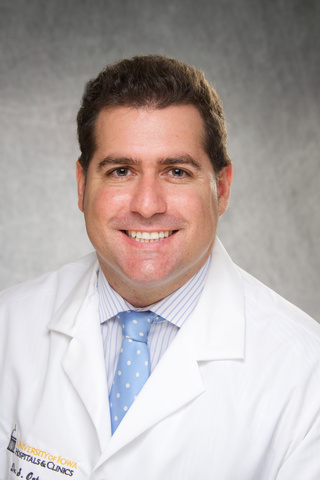Landmark study aims to optimize emergency stroke care and improve outcomes for thousands of thrombectomy patients nationwide

University of Iowa Health Care, in collaboration with Cooper University Health Care, has been awarded research funding by the Patient-Centered Outcomes Research Institute (PCORI) to support a large clinical trial comparing two triage strategies for guiding thrombectomy, a life-saving intervention for patients with large vessel occlusion (LVO) strokes, the most severe and disabling subtype of ischemic stroke.
The study, called DIRECT, is led by Santiago Ortega-Gutiérrez, MD, MSc, clinical professor of neurology, neurosurgery, and radiology in the UI Carver College of Medicine, and Tudor Jovin, MD, medical director of Cooper and Inspira Neuroscience and professor of neurology and neurological surgery at Cooper Medical School of Rowan University. The study seeks to determine whether using a direct-to-angiosuite approach—designed to streamline care and reduce time to thrombectomy—can improve outcomes by speeding up the decision-making process of using thrombectomy without increasing patient risk when compared to the conventional emergency department triage process.
Faster stroke care saves lives
Stroke remains a leading cause of long-term disability, affecting over 795,000 people annually in the United States. LVO strokes, which are caused by blockages in major brain arteries, are particularly devastating, often resulting in profound and permanent impairments of a person’s physical and mental abilities.
Thrombectomy, a relatively new advancement in stroke care, involves using a catheter inserted through the groin or through the wrist to access the blocked artery in the brain and mechanically remove the blood clot, restoring blood flow. This procedure, performed by a highly trained neuro-interventionalist, has proved to be a lifesaving and disability-sparing therapy, but its effectiveness hinges on speed—every minute of delay leads to the loss of thousands of brain cells. Therefore, it is critical to identify patients who have had an LVO as fast as possible so that thrombectomy can be started without delay.
In current practice, stroke patients are typically triaged in the emergency department (ED), where multiple imaging steps may delay treatment decisions. To address this, some hospitals have adopted a direct-to-angiosuite (DTAS) approach, where patients with suspected LVO are taken directly to the operating room (OR), or neurointerventional suite, for initiating thrombectomy, bypassing the ED and using a flat-panel CT scan imaging in the angiosuite to rule out brain hemorrhage.
"Time is brain, and in LVO patients, imaging often takes too long—so, in many ways, imaging is brain, too,” says Ortega-Gutiérrez. “In our recent investigations, we’ve shown that a direct-to-angiosuite strategy can accelerate treatment initiation by at least 30 minutes, a time savings that can mean the difference between recovery and lifelong disability. Every minute matters when treating large vessel occlusion strokes, and this study is a landmark opportunity to rigorously evaluate this approach across diverse health care systems in the United States.
"By confirming the benefits of this streamlined strategy, we aim to reshape stroke care paradigms and ensure that patients, regardless of where they are treated, have access to faster, more effective interventions. This study has the potential to revolutionize the standard of care for suspected LVO strokes nationwide,” he adds.
A nationwide study to transform stroke triage
The DIRECT trial will enroll more than 2,000 patients across 20 leading thrombectomy centers in the U.S. to compare direct-to-angiosuite versus conventional ED triage strategies in real-world stroke care.
“This trial is monumental in scale and significance,” says Jovin, the DIRECT study co-principal investigator. “With more than 20 participating centers nationwide, we are poised to generate practice-changing evidence that addresses a critical gap in stroke care. Our findings will provide clinicians, hospitals, and policymakers with clear guidance on optimizing triage strategies to improve patient outcomes.”
“This study is not just about data—it’s about transforming care for patients facing one of the most severe and time-sensitive neurological emergencies,” adds Jorge Cespedes, MD, UI postdoctoral researcher and the DIRECT trial manager.
Patients enrolled in the study will contribute clinical data during hospitalization and complete follow-up assessments at three months, focusing on recovery, disability, and quality of life outcomes.
This study was selected through PCORI’s highly competitive review process in which patients, caregivers and other stakeholders join scientists to evaluate proposals.
Pragmatic clinical studies, such as this, test a treatment’s effectiveness in “real-world” clinical situations such as standard hospitals and outpatient clinics, and can include a wider range of study participants, making their findings more generally applicable.